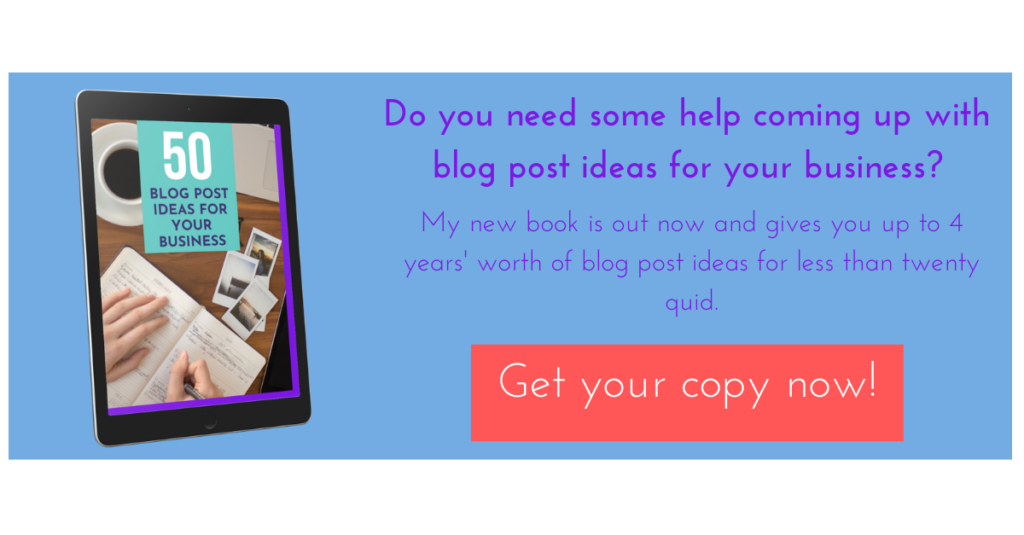 Businesses come in all shapes and sizes, from the sole trader working at home to massive multinationals. The main differences in their marketing strategies tend to come down to budget. If you’re a one person business you’re unlikely to be able to afford to plaster your message on a city centre billboard or nab an ad slot in the middle of ‘Coronation Street’. On the other hand, creating written content is accessible to everyone. Any business can create a blog, but a lot of the people I talk to tell me that they don’t need to as they’re already writing articles. The fact is, while there are similarities they aren’t the same thing. Here’s why.
Businesses come in all shapes and sizes, from the sole trader working at home to massive multinationals. The main differences in their marketing strategies tend to come down to budget. If you’re a one person business you’re unlikely to be able to afford to plaster your message on a city centre billboard or nab an ad slot in the middle of ‘Coronation Street’. On the other hand, creating written content is accessible to everyone. Any business can create a blog, but a lot of the people I talk to tell me that they don’t need to as they’re already writing articles. The fact is, while there are similarities they aren’t the same thing. Here’s why.
Articles are on someone else’s platform
For the purposes of this blog I’m lumping all articles together. In reality, there are hundreds of different outlets for articles. You could be featured in a local magazine or in a professional journal that’s targeted at a specific industry. Finding the right outlet is crucial to raising your profile. When I was a solicitor one of our partners used to write articles about legal issues for food industry journals to showcase his expertise. If you’re offering a service that’s accessible to the general public a local magazine could help you to reach potential customers.
The big difference between these kinds of articles and your own blog is that the articles are all on someone else’s platform. You don’t get to choose how they’re promoted or if you get to publish them at all. An editor has to think about what message will appeal to their readers and it might not be the one you want to send.
Different tones
In marketing it’s important to tailor the tone of voice you use to the platform as well as your audience. If you write articles for a local magazine your tone might be quite similar to that of a blog. By contrast, the difference in tone between a blog and a professional journal article is going to be pretty big.
I find that a lot of professional people shy away from writing blogs because they think it looks unprofessional. A serious article enhances their reputation but a blog might make them look frivolous. I’m generalising here, of course – some of my blog writing clients are very serious businesses. The key difference is that whilst articles make you look professional, a blog makes you look human. They can both win you clients but for very different reasons.
Your audience
When you write an article for a magazine, do you know who is going to read it? You might have been given information about circulation so you know where it’s distributed or who the audience is. It doesn’t tell you who puts it straight in the bin. Even regular readers might stick to their favourite articles and ignore yours completely. The only way you’ll know if your articles have been an effective marketing tool is if someone mentions it when they get in touch.
Now I know that you might have the same issue with your blog. You can’t control who visits your website or whether Facebook shows your post sharing the link to anyone useful. But you can see the data on how many people are reading and where they’re based. You can also run adverts promoting key pieces of content and targeting them at specific people. The results might still be hit and miss but at least you have a fighting chance of discovering what worked and what didn’t.
If you’d like to learn to write blogs, or how to shift your tone from writing articles to something more customer friendly, I’m here to help. Sign up using the form below to find out more about my 1:1 and small group training.
 I know, you’ve heard people like me bang on endlessly about using storytelling in your marketing. It’s a great way to get personality into your content and set yourself apart from the crowd. The thing is, how do you do it? It won’t surprise you to hear that it’s not just a case of telling everyone your life story. It’s all about balance. Your customers will love the fact that you’re relatable but they mainly want to hear about how your business can benefit them. Here’s how you can start using storytelling in your marketing.
I know, you’ve heard people like me bang on endlessly about using storytelling in your marketing. It’s a great way to get personality into your content and set yourself apart from the crowd. The thing is, how do you do it? It won’t surprise you to hear that it’s not just a case of telling everyone your life story. It’s all about balance. Your customers will love the fact that you’re relatable but they mainly want to hear about how your business can benefit them. Here’s how you can start using storytelling in your marketing. Whenever you create a new piece of content for your business you need to think about what you want it to do. I know that might feel as if I’m asking you to analyse every single little thing that you put out there (and I am) but it doesn’t have to be a pain. Your marketing has one really simple job to do. It needs to tell customers that you exist and convince them that you have something they need. I know it’s not that easy in practice but it gives you a good starting point. There are loads of ways that your content can achieve your aims. It could explain the benefits of what you offer, educate your audience or just raise awareness of your brand. Whatever you want each post to do, you need to follow it up with a good call to action. Here’s how it works.
Whenever you create a new piece of content for your business you need to think about what you want it to do. I know that might feel as if I’m asking you to analyse every single little thing that you put out there (and I am) but it doesn’t have to be a pain. Your marketing has one really simple job to do. It needs to tell customers that you exist and convince them that you have something they need. I know it’s not that easy in practice but it gives you a good starting point. There are loads of ways that your content can achieve your aims. It could explain the benefits of what you offer, educate your audience or just raise awareness of your brand. Whatever you want each post to do, you need to follow it up with a good call to action. Here’s how it works.
 I had a fabulous meeting with a lovely lady recently and it got me thinking (again) about all the different skills you need in business. She was talking about all of the different elements that she was bringing together to make sure that the message she was sending reflected her values and the work that she does. Talking to me about getting the words right was the next stage in the process. She’d written a few things herself but hadn’t been happy with them. It’s a common theme when I speak to small business owners. There seems to be this feeling that they should be able to do it themselves. Writing is easy, right? If you’re holding back from working with a writer because you feel you shouldn’t have to, here’s why you might want to reconsider.
I had a fabulous meeting with a lovely lady recently and it got me thinking (again) about all the different skills you need in business. She was talking about all of the different elements that she was bringing together to make sure that the message she was sending reflected her values and the work that she does. Talking to me about getting the words right was the next stage in the process. She’d written a few things herself but hadn’t been happy with them. It’s a common theme when I speak to small business owners. There seems to be this feeling that they should be able to do it themselves. Writing is easy, right? If you’re holding back from working with a writer because you feel you shouldn’t have to, here’s why you might want to reconsider.